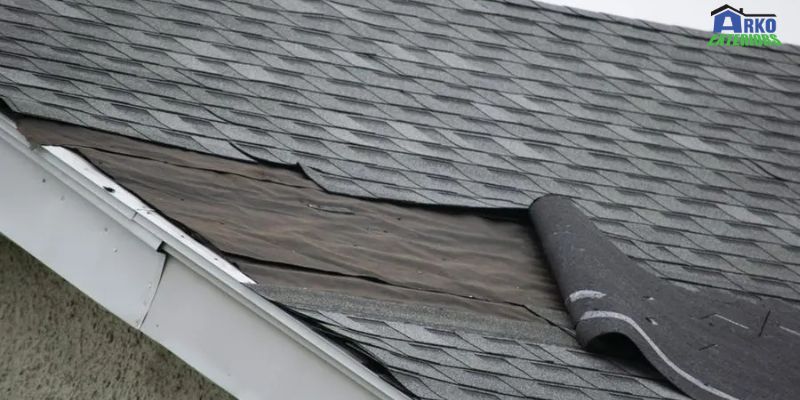Nobody wants to invest in a new roof until the time is right. Without prior roofing knowledge, it is difficult to look up at your roof and know when a replacement is necessary. As a result, you must take the required actions and know when it is appropriate to replace your roof.
Signs That You Need A Roof Replacement

Some signs that you need to replace the roof of your home are obvious while others are not. The following are the main signs that your home needs a new roof…
#1 Roof Leaks

A leak is an obvious indication that your roof needs to be repaired or replaced. An inspection is required to decide whether a repair is sufficient. To determine whether a replacement is necessary, get several opinions, especially for a roof that is more than 10-years-old.
#2 Missing, Cracked Or Curling Roof Shingles
A replacement is required when worn asphalt shingles start to curl, crack or go missing. Shingle aging is indicated by curling and cracking. Climbing the roof might be necessary to find this.
Roof installation problems or wind are the causes of missing shingles. The contractor’s warranty is a deciding factor in a poor installation. In any case, replacing damaged shingles is frequently necessary.
#3 Granules On The Ground Or In The Gutters
Shingles contain granules that provide UV protection, color and fire resistance. They are essential to the endurance of an asphalt roof. Losing them indicates that a replacement is required.
Keep an eye out for loose granules, which are a result of wear, in gutters or close to downspouts. Granule loss can also happen because of hail, particularly during a storm.
#4 Discolored Or Rotted Decking
Roof decking, the foundation of your roof, is essential for the installation of materials. The decking that has been compromised needs to be replaced, and a new roof may be necessary. Without removing the old roof, it is difficult to see.
Finding rot or discoloration in your attic is a sign of trouble. This happens as a result of water leaking from below or through roofing materials. If ignored, severe damage puts the roof at risk of collapsing.
#5 Moss Growth
It is time to start considering a replacement if moss or other vegetation is growing on your roof. Currently, you might see some black streaks on your roof brought on by algae.
Even though algae can grow on a roof that is 10 to 15 years old, this doesn’t always mean that the roof needs to be replaced. You can fortunately remove the algae from your roof.
The Pros Of Roof Replacement
The benefits of a roof replacement can vary depending on factors like the quality of materials used, the expertise of the installer and the specific climate conditions in your area. You should expect the following benefits:
- Improved energy efficiency: A new roof can provide better insulation and ventilation, leading to improved energy efficiency. This can result in lower heating and cooling costs, as your home’s temperature regulation becomes more effective.
- Increased home value: A roof replacement can significantly boost your home’s curb appeal and overall value. Potential buyers are more likely to be attracted to a property with a new, well-maintained roof.
- Enhanced protection: A new roof offers better protection against the elements, including rain, wind, snow and UV rays. This can prevent leaks, water damage and other structural issues that may arise from an old or deteriorating roof.
- Reduced maintenance costs: Older roofs often require frequent repairs and maintenance to address issues like leaks, shingles lifting or cracks. By replacing your roof, you can reduce the need for constant repairs and enjoy a more hassle-free maintenance experience.
- Warranty coverage: Many roofing materials come with warranties that cover a certain period, typically 20 to 50 years. This means that if any issues arise due to manufacturing defects or other problems within the warranty period, the cost of repairs or replacements may be covered by the manufacturer or installer.
The Cons Of Roof Replacement
There are cons associated with a roof replacement. Therefore, you should consult with roofing professionals to help mitigate the following challenges:
- Cost: Roof replacement can be a significant financial investment. The cost depends on factors such as the size of your roof, the type of materials used and the complexity of the installation. It is important to budget for this expense and consider the potential impact on your finances.
- Disruption: Roof replacement involves a certain level of disruption to your daily life. The process can be noisy and messy, with construction materials and debris around your property. Depending on the scope of the project, you might need to temporarily relocate or make arrangements to accommodate the construction.
- Time-consuming: Roof replacement is not a quick process. It can take several days to a few weeks to complete, depending on the size of the roof and other factors. During this time, your home may be exposed to the elements, which could potentially lead to interior damage if precautions are not taken.
- Environmental impact: Roof replacement generates waste materials, such as old shingles and other roofing components. While some of these materials can be recycled, the overall environmental impact of disposal and production of new roofing materials should be considered.
- Unforeseen issues: Once the old roof is removed, hidden issues might be revealed, such as structural damage or rot. Addressing these problems can lead to additional costs and extended project timelines. It is important to factor in the possibility of unexpected issues arising during the replacement process.
Summary:
It is important to think carefully before choosing a new roof. While there are pros, such as improved protection and increased home value, it is important to consider the costs and potential disruptions as well. Before making this important choice, evaluate your situation.

